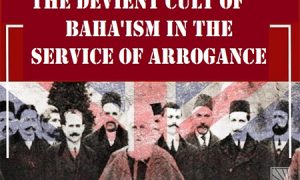The historical documents indicate that the bond and cooperation between the Baha’is and America is more than a century. For example, Mr. Shuster, the famous American advisor came to Iran earlier the second Constitution as the general headman of the Iranian assets. Ordered by the Baha’i assembly, a group of the Baha’is of Tehran city welcomed him when he arrived in Tehran.[1] Basically Ali Qoli Khan Nabil-Al-Duleh (the member of Masonry of America) played a key role.
Dr. Millspaugh – another American advisor came to Iran after Shuster. He elected some of the people in charge of the assets among the members of the cult particularly during his second mission in Iran (earlier Muhammad Reza’s Kingdom) opposed by some parliament representatives such as Ayatollah Hajj Sheikh Hussein Lankarani and the then press. It is understood by the secret telegraph of Mokhber_al-Saltanerh Hedayat, the ruler of Fars in World war I to the domestic minister dated Jamadi-al-thani, 17, 1332 A.H. that Colonel Meril the American officer of gendarmery who was active in the treasury gendarmery of Iran during Ahmad Shah’s period of time before the arrival of the Sweden officers to Iran. One of the Baha’i proselytizers called Rouhullah Khan was appointed as his translator: Hedayat adds in the Telegraph that Meril’s action was opposed by the scholars and others and he had promised to send the mentioned person to America along with his mother-in-law, but just his mother-in-law was sent…[2]
The Baha’is were usually using their relationships with America to put the Iranian officials under pressure. For instance, Ms. Louis Moreh (one of the active Baha’is (the west) threatened the Iranian ambassador in Paris (Nazar Agha Yaminussaltaneh). He asked for visiting the king Mozaferuddin when he was in Paris. When the Iranian ambassador prevented, she threatened: “I immediately go to the American minister plenipotentiary resided in Paris and will see the chancellor with him. Nazar Agha Khan asked: Is the American ambassador Baha’i? I answered back: It doesn’t differ for you whether he is Baha’i or not… .“[۳]
According to the existent historical documents, the presence of the Baha’is in America goes back to earlier 14th century. For the first time, in the lunar month of Ramadhan, 30, 1318 A.H., a secret report about the activities of this group in Chicago was sent to Tehran to make the higher official aware. The minister of Iran in America reports that a group of Babi, Baha’i heads who have come to the city have visited him. They claim for the presence of nearly one hundred Babi Baha in America which is called by the minister as eggagrative and it is guessed for the population of the Baha’is of America as 10 thousand people. He reports that this gray are wealthy, authors and influential who have Ph.D. degrees. They have established centers to educate the kids, orphans and to cure the ill. He asked for two secret agents to get information about their manners and behaviors. It is declared in the report dated Jamadiul Oula, 12, 1319 A.M. that the mentioned people have followed the Iranian news. They have even. put the Iranian government under pressure in the American cultural and political assemblies to give more freedom to the Baha’i minority. The Baha’i measures resided in America caused for the embassy of that country in Tehran to support this minority.[4]
Sir Arthur Harding (the British minister plenipotentiary during the years near the Constitution) writes in his diary: “The American proselytizers residing in Iran believed that the religious future of this country belongs to the Babis![5]
[۱] Refer to the introduction of Ismaeel Raeen on the book ” strangulation of Iran” translated by Abul Hassan Mousaw: Shushtari, pp.10-11.
[۲] the documents of World War I in Iran, p.82.
[۳] Ahang-e-Badia, year: 24, (1348), No. 7& 8, pp. 187 & 190, the article of seth Luagstinger written by Muhammad Ali Feizi
[۴] The investigation of Iran and America relations (1851 to 1925 A.D.) vol.2, the center for publishing of the ministry of foreign affairs, 1384 S.H., pp. 136-137.
[۵] Sir Arthur Harding’s memoirs, translated by Dr. Sheikhul Islami, Keyhan publishing house, p. 216.






